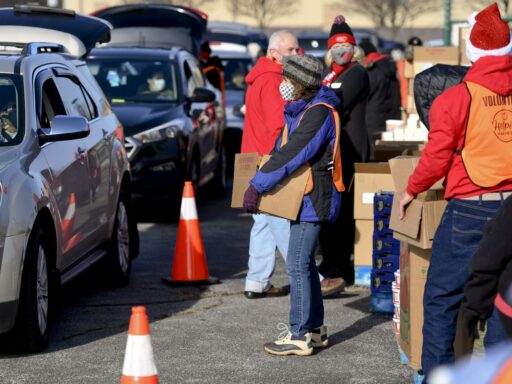More money for food would be an important part of a new relief bill.
Food insecurity in the US is the worst it’s been in years, and Congress has a clear way to address it: Expand SNAP.
SNAP, which stands for the Supplemental Nutrition Assistance Program, enables eligible individuals and families to get monthly support for food, including a maximum of $204 for an individual and $680 for a family of four in most states. Previously known as food stamps, it’s a form of direct aid accessible to anyone who earns below a certain income threshold and meets other resource requirements.
Increasing the amount of money people receive in SNAP benefits each month is far from enough to address the current rate of food insecurity, but it would help those who need this relief, and it would alleviate some of the strain on food banks across the country.
According to data gathered by Feeding America, 50 million people could be food insecure this year, compared to 35 million who said they struggled with hunger in 2019, suggesting a sharp increase in those who may need help.
“The surge that’s occurring now is greater than what we saw earlier in the year,” says Catherine D’Amato, the head of the Greater Boston Food Bank. “I’ve never seen anything like it and I hope to never see anything like it again.” Food banks in many states continue to see huge lines and hours-long waits for food, with demand rising in the spring and then going up again this past fall.
It’s not currently clear what a SNAP expansion could look like in a new package or if one is included. Previously, a bipartisan group of lawmakers had proposed including a 15 percent expansion of monthly SNAP benefits in a new stimulus bill — a boost that could quickly get people more money in the near term. House Majority Leader Steny Hoyer signaled Thursday, however, that SNAP aid was among the sticking points that negotiators were still working through, a sign that it may face some opposition.
Experts in the field, meanwhile, emphasize that expanding SNAP is a critical policy change that would help millions grappling with the fallout of the pandemic and directly stimulate the economy at the same time.
“The biggest failure is not providing enough purchasing power right now,” says Ellen Vollinger, a legal director at the Food Research & Action Center.
How a SNAP expansion would help
SNAP benefits would help in a couple of ways: They could quickly get more money to people who need it, who could then spend it at grocery stores and other retailers, further bolstering the economy. As Moody’s Analytics has previously estimated, every dollar that’s distributed through SNAP translates to a $1.70 boost to the economy.
A SNAP expansion would also make sure that the poorest households are able to get more help as the economic downturn continues. Previously, the Families First Coronavirus Response Act had ensured that all households could receive the maximum SNAP benefit per month, a change that didn’t help those who were already receiving that amount. Any expansion of the monthly maximum would make sure that all people in the program saw an increase in aid.
More SNAP, in conjunction with additional UI relief and stimulus checks, could help people weather thousands of business closures and layoffs that are continuing as the result of the pandemic. According to the latest Labor Department report, 19 million people are currently receiving unemployment insurance.
A more generous SNAP program would also help reduce the overwhelming demand that food banks are seeing across the country, as they try to serve those who don’t get enough aid from the program, those who don’t qualify or those who might not know about it. Feeding America, the country’s largest network of food banks, had projected shortfalls of $1.4 billion earlier this year as demand and costs have spiked. D’Amato notes that much of her work has focused on educating people about SNAP and confronting the stigma around it as well.
“The demonizing of SNAP over the years has made it harder for people who want to be associated with the program or seen as needing it,” says Vollinger. For people who may newly be in need, states are required to be responsive and get back to people within 30 days of their applications for the program, she notes.
There’s longstanding evidence — including from the previous recession — that increasing SNAP benefits is good for individual households and the broader economy.
During the economic recession in 2008, Congress expanded SNAP benefits by 13.6 percent on a monthly basis and saw reduced food insecurity in 2009 among those who qualified for the program. At the time, more households saw their benefits cover food for a longer period of time as well as improved health outcomes.
“The evidence is that this helped a lot of people weather the recession and the same thing could be done now,” Duke University public policy professor Anna Gassman-Pines previously told Vox.
Author: Li Zhou
Read More



